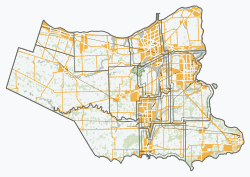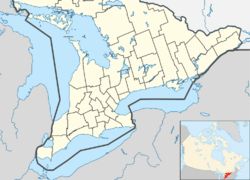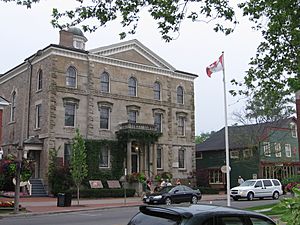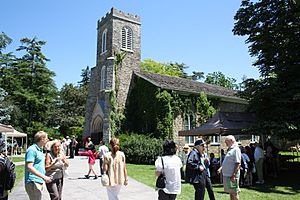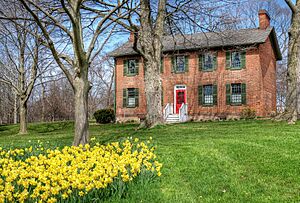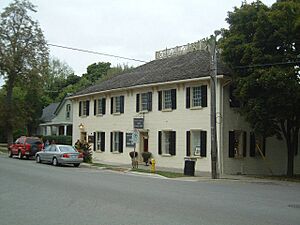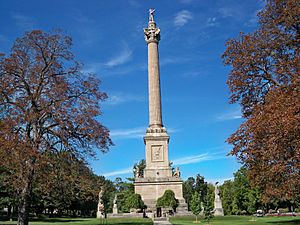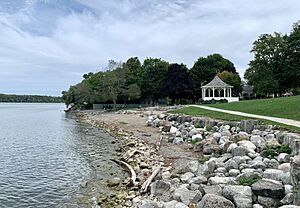Niagara-on-the-Lake facts for kids
Quick facts for kids
Niagara-on-the-Lake
|
||
|---|---|---|
|
Town (lower-tier)
|
||
| Town of Niagara-on-the-Lake | ||
 |
||
|
||
| Country | ||
| Province | ||
| Region | Niagara | |
| Settled | 1781 | |
| Incorporated | 1792 | |
| Area | ||
| • Land | 132.81 km2 (51.28 sq mi) | |
| Elevation | 82.3 m (270.0 ft) | |
| Population
(2021)
|
||
| • Total | 19,088 | |
| • Density | 131.8/km2 (341/sq mi) | |
| Demonym(s) | NOTLer | |
| Time zone | UTC-5 (Eastern (EST)) | |
| • Summer (DST) | UTC-4 (Eastern Daylight (EDT)) | |
| Postal code |
L0S 1J0
|
|
| Area code(s) | 905/289 | |
| Website | www.notl.org | |
Niagara-on-the-Lake is a charming town in Ontario, Canada. It sits on the Niagara Peninsula, right where the Niagara River flows into Lake Ontario. Across the river, you can see New York in the United States.
This town is part of the Niagara Region. It's special because it's the only town in Canada with a lord mayor. In 2021, about 19,088 people lived here.
Niagara-on-the-Lake has a rich history for Canada. It was once the very first capital of Upper Canada, which is what Ontario was called before. From 1792 to 1797, it was known as Newark. During the War of 1812, many battles happened here. The town was even burned down.
Today, Niagara-on-the-Lake is a popular spot for tourists. People love its old-fashioned buildings and the famous Shaw Festival. You can also visit Fort George, explore local wineries, or shop at the outlet mall. It's also very close to the amazing Niagara Falls.
Contents
History of Niagara-on-the-Lake
Before British settlers arrived, different Native American tribes lived here. These included the Neutral Nation in the 1400s, the Seneca people in the late 1600s, and the Mississauga people in the 1700s.
The town started in 1781 and was first called Butlersburg. This name honored Colonel John Butler, who led a group called Butler's Rangers. Later, it was called West Niagara to tell it apart from Fort Niagara.
It became a British military base. Many loyalists (people who supported Britain) came here after the American Revolution. In 1792, Lieutenant-Governor John Graves Simcoe renamed it Newark. It became the first capital of Upper Canada.
The government of Upper Canada met at Navy Hall starting in 1792. But in 1797, Simcoe moved the capital to York (now Toronto). This was because Newark was too close to the U.S. border. In 1798, Newark was renamed Niagara.
War of 1812 and Rebuilding
Fort George was built near the town between 1796 and 1799. During the War of 1812, American forces attacked Niagara in May 1813. They bombed the town and then captured Fort George.
The British took back the fort in December 1813. As American soldiers left Niagara, they burned the town to the ground. But the people of Niagara didn't give up! They rebuilt their town after the war. They moved the main part of town, including the new court house, further away from Fort Niagara's cannons.
Fort Mississauga was also built during this time, starting in 1813. It was finished after the war in 1816.
In 1859, the town opened its first public school, Niagara Public School. The name Niagara-on-the-Lake was first used around 1880. This helped people tell it apart from Niagara Falls. The town officially adopted the name in 1970 when the Town of Niagara and the Township of Niagara joined together.
Historic Sites to Explore
Many old military sites have been restored. These include Fort George, Navy Hall, and Butler's Barracks. Fort George was restored in the 1930s, showing how important it was to save history.
Fort George National Historic Site is a key spot among many War of 1812 sites. Parks Canada manages these sites, which also include Fort Mississauga, the Mississauga Point Lighthouse (the first on the Great Lakes), and Queenston Heights.
Niagara-on-the-Lake has many historical markers. Important battles to defend Upper Canada happened here. Laura Secord became famous for walking 32 km in 1813 to warn British forces about an American attack. The town was also a safe place for people escaping slavery on the Underground Railroad.
The town's old buildings, built after the War of 1812, are considered some of the best in Canada. Because of this, the historic district was named a National Historic Site of Canada in 2003.
Other historic places in town include:
- The Old Court House Theatre, built in 1847.
- Queen's Royal Park, where the Queen's Royal Hotel used to be.
- St. Mark's Church, one of the oldest Anglican churches in Ontario.
- St. Vincent de Paul, the oldest Catholic church in Ontario.
- The McFarland House, the oldest building in town.
- The Niagara Public School, built in 1859.
- The Niagara Golf Club, the oldest golf course in North America still in use.
Climate and Weather
Niagara-on-the-Lake has four seasons: warm summers, cold winters, and mild autumns and springs. It gets about 92 cm (3 feet) of snow each year, which is less than many other parts of Ontario. Being close to Lake Ontario helps keep temperatures more moderate.
| Climate data for Niagara-on-the-Lake (1981–2010) | |||||||||||||
|---|---|---|---|---|---|---|---|---|---|---|---|---|---|
| Month | Jan | Feb | Mar | Apr | May | Jun | Jul | Aug | Sep | Oct | Nov | Dec | Year |
| Record high °C (°F) | 18.0 (64.4) |
16.0 (60.8) |
23.5 (74.3) |
29.0 (84.2) |
33.0 (91.4) |
35.0 (95.0) |
35.5 (95.9) |
34.0 (93.2) |
33.0 (91.4) |
28.0 (82.4) |
22.5 (72.5) |
16.5 (61.7) |
35.5 (95.9) |
| Mean daily maximum °C (°F) | 0.2 (32.4) |
0.2 (32.4) |
4.4 (39.9) |
10.9 (51.6) |
17.6 (63.7) |
23.4 (74.1) |
26.3 (79.3) |
25.3 (77.5) |
21.0 (69.8) |
14.8 (58.6) |
8.4 (47.1) |
2.2 (36.0) |
12.9 (55.2) |
| Daily mean °C (°F) | −3 (27) |
−3.2 (26.2) |
0.7 (33.3) |
6.7 (44.1) |
12.6 (54.7) |
18.4 (65.1) |
21.7 (71.1) |
20.9 (69.6) |
16.6 (61.9) |
10.7 (51.3) |
5.0 (41.0) |
−0.8 (30.6) |
8.9 (48.0) |
| Mean daily minimum °C (°F) | −6.3 (20.7) |
−6.6 (20.1) |
−3.0 (26.6) |
2.4 (36.3) |
7.5 (45.5) |
13.4 (56.1) |
17.0 (62.6) |
16.4 (61.5) |
12.2 (54.0) |
6.5 (43.7) |
1.5 (34.7) |
−3.8 (25.2) |
4.8 (40.6) |
| Record low °C (°F) | −26.0 (−14.8) |
−20.0 (−4.0) |
−16.0 (3.2) |
−9.5 (14.9) |
−1.5 (29.3) |
4.0 (39.2) |
8.5 (47.3) |
5.0 (41.0) |
1.0 (33.8) |
−5.0 (23.0) |
−10.0 (14.0) |
−19.5 (−3.1) |
−26.0 (−14.8) |
| Average precipitation mm (inches) | 55.1 (2.17) |
51.0 (2.01) |
57.7 (2.27) |
81.1 (3.19) |
81.9 (3.22) |
75.8 (2.98) |
79.2 (3.12) |
74.9 (2.95) |
91.8 (3.61) |
76.8 (3.02) |
88.1 (3.47) |
66.5 (2.62) |
879.6 (34.63) |
| Average rainfall mm (inches) | 30.1 (1.19) |
23.8 (0.94) |
43.5 (1.71) |
76.6 (3.02) |
81.9 (3.22) |
75.8 (2.98) |
79.2 (3.12) |
74.9 (2.95) |
91.8 (3.61) |
76.8 (3.02) |
84.1 (3.31) |
49.0 (1.93) |
787.4 (31.00) |
| Average snowfall cm (inches) | 24.9 (9.8) |
27.2 (10.7) |
14.1 (5.6) |
4.5 (1.8) |
0.0 (0.0) |
0.0 (0.0) |
0.0 (0.0) |
0.0 (0.0) |
0.0 (0.0) |
0.0 (0.0) |
4.0 (1.6) |
17.5 (6.9) |
92.2 (36.3) |
| Average precipitation days (≥ 0.2 mm) | 14.6 | 10.8 | 12.6 | 14.2 | 12.6 | 11.3 | 11.0 | 11.5 | 12.5 | 13.8 | 15.7 | 13.5 | 154.3 |
| Average rainy days (≥ 0.2 mm) | 6.9 | 5.0 | 9.5 | 13.1 | 12.6 | 11.3 | 11.0 | 11.5 | 12.5 | 13.8 | 14.4 | 8.5 | 130.3 |
| Average snowy days (≥ 0.2 cm) | 8.8 | 6.9 | 4.3 | 1.6 | 0.0 | 0.0 | 0.0 | 0.0 | 0.0 | 0.0 | 1.5 | 6.1 | 29.1 |
| Source: Environment Canada | |||||||||||||
Population Facts
| Census | Population |
|---|---|
| 1871 | 1,600 |
| 1901 | 1,258 |
| 1911 | 1,318 |
| 1921 | 1,357 |
| 1931 | 1,228 |
| 1941 | 1,541 |
| 1951 | 2,712 |
| 1961 | 2,108 |
| 1971 | 12,552 |
| 1981 | 12,186 |
| 1991 | 12,945 |
| 2001 | 13,839 |
| 2006 | 14,587 |
| 2011 | 15,400 |
| 2016 | 17,511 |
| 2021 | 19,088 |
In 2021, the population of Niagara-on-the-Lake was 19,088 people. This was a 9% increase from 2016. The town has a land area of about 131.35 square kilometers. This means there were about 145.3 people living in each square kilometer in 2021.
Town Communities
Besides the main town area (called the Old Town), Niagara-on-the-Lake includes several smaller communities. These are Colemans, Homer, McNab, Mississauga Beach, Queenston, St. Davids, and Virgil.
- Glendale is near major highways like the Queen Elizabeth Way. It's home to the Niagara-on-the-Lake campus of Niagara College. There's also a big outdoor shopping mall here.
- Virgil is just southwest of the Old Town. Many tourists visit this area. It has a large Mennonite community who moved here from Russia. Virgil has a big sports park with arenas and baseball fields. It's a busy place for hockey, softball, lacrosse, and soccer. Every May, the community holds its "Virgil Stampede" festival.
- Queenston is another historic community within the town.
Schools in the Area
- St. Davids Public School teaches students from Junior Kindergarten to Grade 8.
- St. Michael Catholic Elementary School also serves students from Junior Kindergarten to Grade 8.
- Crossroads Elementary School is for students from Junior Kindergarten to Grade 8.
- High school students from Niagara-on-the-Lake usually take a bus to schools in St. Catharines or Niagara Falls.
Economy and Tourism
Niagara-on-the-Lake is a big tourist spot.
- The town is home to the Shaw Festival. This is Canada's second-largest theater company. They perform plays by George Bernard Shaw and other writers from his time (1856–1950). The festival runs from April to December.
- The RiverBrink Art Museum in Queenston has over 1,400 artworks. It was once the home of Samuel E. Weir and became an art museum after he passed away.
- The Historic Old Town is full of unique shops and restaurants.
- In 2014, the Outlet Collection at Niagara opened. It's Canada's largest outdoor outlet mall.

Getting Around
You can reach Niagara-on-the-Lake by driving on the Queen Elizabeth Way highway. This highway connects to other cities like Fort Erie, Hamilton, and Toronto. For public transportation, the town has Niagara-on-the-Lake Transit.
Sports and Recreation
Niagara-on-the-Lake has a long history of boating. There are two boat clubs: the Niagara-on-the-Lake Sailing Club and Smuggler's Cove Boat Club.
The town also has a junior men's hockey team called the Niagara Predators. They play at the Meridian Credit Union Arena in Virgil. This arena was built between 2003 and 2005.
Niagara-on-the-Lake also has a men's soccer team, the Lakers. They play in the Peninsula Soccer League (PSL). The town also has a strong history in the sport of lacrosse.
Awards and Special Recognition
In 1955, Niagara-on-the-Lake hosted the 8th World Scout Jamboree. Over 11,000 Scouts from 71 countries attended this big event. It was the first time the Jamboree was held outside of Europe.
In 1996, the town was named the "Prettiest Town in Canada" by Communities in Bloom. Today, it's a very popular place for tourists. It's located at the start of the Niagara Parkway, which is a beautiful road and path for biking and walking.
See also
 In Spanish: Niagara-on-the-Lake para niños
In Spanish: Niagara-on-the-Lake para niños



